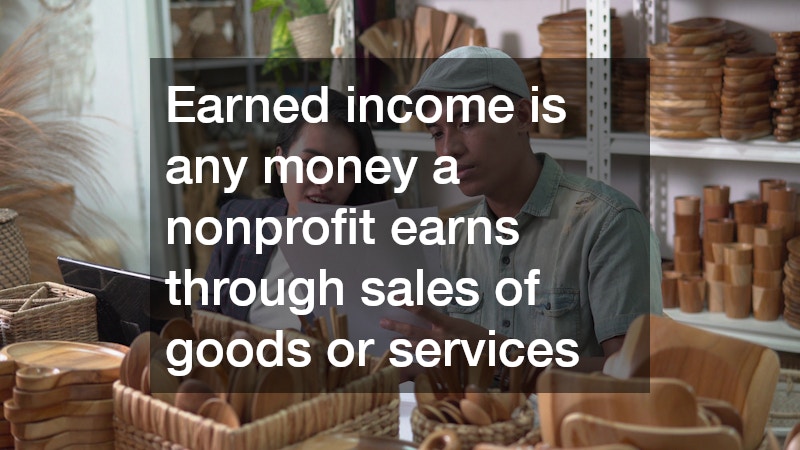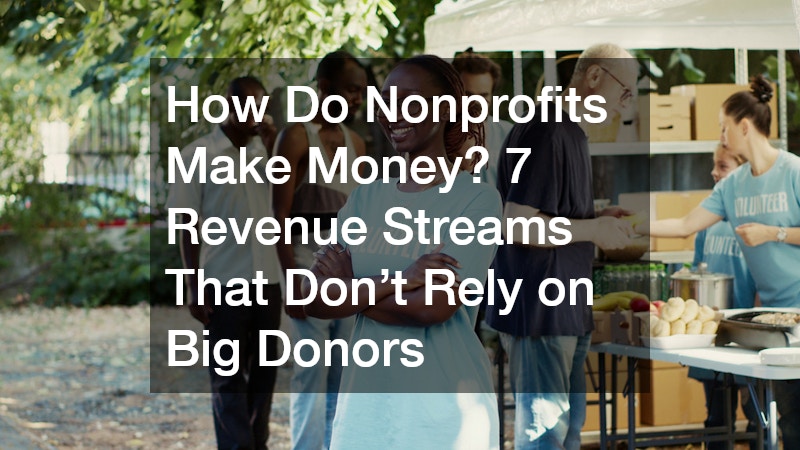When most people think about nonprofits, they picture fundraising galas, wealthy benefactors, and grant applications. But here’s the reality: many nonprofits can’t (and don’t) rely solely on big donors to keep the lights on.
So, how do nonprofits actually make money?
The answer: through a mix of creative, consistent, and sustainable revenue streams that go way beyond writing checks and hoping for the best.
If you’re starting a nonprofit or looking to diversify your organization’s income, you’ll want to explore these seven revenue streams that don’t rely on big donors.
1. Earned Income: Can a Nonprofit Sell Products or Services? Yes.

One of the most overlooked strategies for nonprofit revenue is selling something. While this surprises many people, the IRS absolutely allows nonprofits to earn income—as long as it aligns with the organization’s mission.
Earned income is any money a nonprofit earns through sales of goods or services. If you’ve been researching how to start a nonprofit organization with no money, earned income should be one of the first models you explore. It empowers you to generate funding from day one—without relying on grants or wealthy donors.
Examples of Earned Income:
- Workshops, webinars, or training programs – Nonprofits that specialize in education or training can charge for access to courses.
- Merchandise – Selling branded items (t-shirts, tote bags, mugs) is a popular and profitable strategy.
- Ticketed events – Whether it’s a virtual summit or a film screening, charging admission is allowed.
- Consulting services – If your nonprofit has unique expertise (e.g. in urban gardening or restorative justice), others may pay to learn from you.
Just make sure it stays mission-aligned, or you could run into Unrelated Business Income Tax (UBIT) issues.
2. Membership Fees: Why Do People Pay to Join a Nonprofit?
Membership models are a smart way to build community and bring in recurring revenue. This works especially well for advocacy groups, professional associations, or cultural organizations.
What’s in it for members?
- Access to exclusive content or events
- Voting rights or a say in organizational decisions
- Discounts on events or products
- A sense of belonging and shared purpose
By offering a clear value proposition, you create a revenue stream that grows with your audience.
3. Grants: Is Grant Funding Really Reliable?
Grants can be an incredible source of revenue—but they’re not always easy to get, and they shouldn’t be your only strategy.
Grants come from:
- Foundations (private or family)
- Corporations
- Government agencies
They’re often tied to specific programs or goals and may come with reporting requirements. While grants can fund new initiatives or scale impact, remember they usually aren’t permanent and must be reapplied for.
Tip: Focus on project-specific grants rather than trying to fund your entire organization this way.
4. Social Enterprises: What Happens When Nonprofits Think Like Businesses?
A social enterprise is a business operated by a nonprofit with the goal of funding the mission. It’s where impact meets innovation.
Real-world Examples:
- A nonprofit job training program that runs a coffee shop staffed by trainees
- A homeless services nonprofit that sells handmade goods from shelter residents
- An environmental nonprofit that offers eco-consulting services
The key is that the profits from these enterprises go back into the mission—not into the pockets of shareholders.
Starting a social enterprise takes planning, but it’s one of the most sustainable ways for nonprofits to become financially independent.
5. Fee-for-Service: Can You Charge for Your Impact?
Some nonprofits provide services that are so valuable that clients, governments, or partners are willing to pay for them.
This is called fee-for-service, and it’s particularly common in:
- Healthcare nonprofits billing Medicaid or private payers
- Educational nonprofits charging schools for curriculum packages
- Environmental nonprofits offering assessments or certifications
If your nonprofit provides a service that meets a tangible need, fee-for-service might be the path to sustainable growth.
6. Corporate Sponsorships: Are Businesses Willing to Partner with Nonprofits?
Yes—and often for their own branding and CSR (corporate social responsibility) goals.
Corporate sponsorship is different from traditional fundraising. It’s transactional, not charitable. In exchange for visibility or co-branding, a business agrees to support your event, program, or campaign.
What can you offer sponsors?
- Logo placement on event banners or websites
- Recognition in email newsletters
- Speaking opportunities at events
- Access to your audience or members
To succeed with sponsorships, think about what your organization can offer in return. It’s a partnership, not a favor.
7. Crowdfunding and Monthly Giving: What About the Little Donors?

Okay, so we said “no big donors”—but that doesn’t mean no donors. In fact, small donors can become the lifeblood of a nonprofit, especially when giving is easy and consistent.
Crowdfunding:
Short-term, campaign-based fundraising works great when you have a specific project, goal, or story. Platforms like GoFundMe, Classy, or MightyCause make it easy to raise money online from a wide audience.
Monthly Giving:
Recurring donations provide predictable income. Even $10 a month from 100 people = $12,000 a year.
How to get started:
- Make monthly giving the default option on your site
- Offer perks or recognition to recurring donors
- Show the impact of their consistent support
This “people-powered” approach builds long-term financial resilience without needing a single high-net-worth individual to carry your budget.
Why Diversifying Your Revenue Matters
The most sustainable nonprofits don’t depend on just one or two sources of income. They build diverse revenue portfolios that reduce risk and increase flexibility.
Benefits of revenue diversification:
- Protection from economic downturns
- Ability to invest in new programs
- Less time chasing big checks
- More autonomy in decision-making
You don’t need to launch all seven streams at once—but start with one or two that align with your mission, audience, and capacity.
Quick Recap: 7 Nonprofit Revenue Streams (Beyond Big Donors)
Here’s a cheat sheet you can use when brainstorming income strategies:
- Earned Income – Sell products, services, or experiences.
- Membership Fees – Build a paying community.
- Grants – Fund programs with foundation or government money.
- Social Enterprises – Launch a business to support your cause.
- Fee-for-Service – Charge for your value.
- Corporate Sponsorships – Partner with companies for mutual gain.
- Crowdfunding & Monthly Giving – Tap into the power of small donors.
Final Thoughts: How Do Non Profits Make Money While Making a Difference?
Nonprofits exist to serve, not to sell—but that doesn’t mean they can’t (or shouldn’t) generate income. In fact, developing reliable revenue streams is one of the smartest things you can do for your mission.
So if you’ve ever asked, “How do nonprofits make money without big donors?”, now you know: they earn it, build it, charge for it, and grow it—creatively and consistently.
Start with what fits your vision, test what works, and remember: financial sustainability is mission sustainability.




